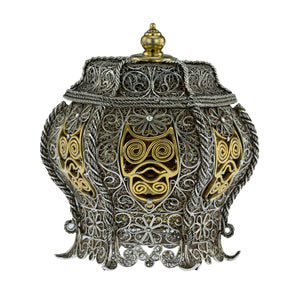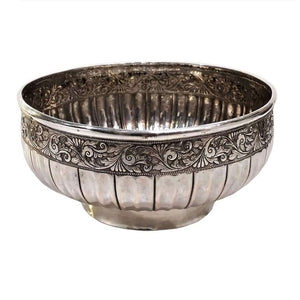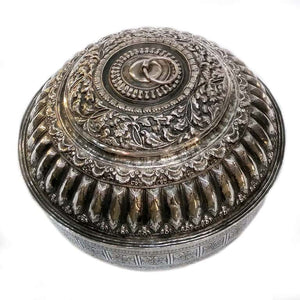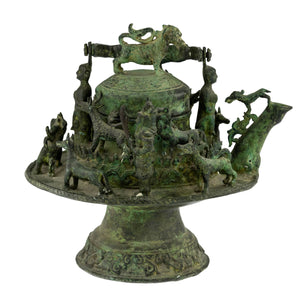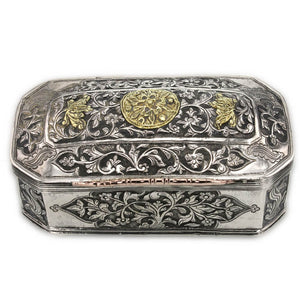Malay silverwork is ornamented with floral and geometrical patterns. There are no depictions of animals or religious figures on Malay work, since these depictions are considered improper to Muslims. Unlike silver from India and China, the pieces contain large amounts of whitespace. This unembellished space enhances the effect of the artistry by providing balance and contrast. Whilst some pieces may appear simplistic, each piece is a unique creation. As H. Ling Roth writes in his book, ’Oriental Silverwork’, ” ….. the artist creates each piece as a composition with no ‘extra’ ornamentation and the ornamentation itself is appropriate to the form and function of the object. Additionally, each piece contains a unique and original design, with little imitation done by the artist.” Traditionally, silversmiths worked for Malay royalty, who had a suite of silversmiths to provide all the silverwork they and their courts required. Later on, silver objects were made for the aristocracy of Malaysian society. Finding Malaysian silver can be a challenge since it is mostly unknown outside Malaysia and is often confused with Indian and other Asian silver.
In Indonesia, silversmiths enjoyed high status within the artisan community and received their commissions from the local nobility and upper classes. The silversmiths of Kota Gede, a settlement a few kilometers from Djokjakarta (Jakarta), were particularly famed and served the demands of the Royal Courts. After European colonisation, the status and wealth of their patrons declined, as did the number and value of commissions, significantly impacting demand and threatening the silversmiths’ business viability. In the early 1900s, the Indonesian silver industry was in danger of disappearing until, in 1930, the wife of the Governor of Yogyakarta (Jakarta), Mrs Mary Agnes Gesseler Verschuir-Pownall, regenerated the silver industry by persuading the silver workers to broaden their repertoire to include items which would more directly appeal to the resident colonial administrators and Dutch settlers. Her intervention was successful and through this new direction plus the establishment of workshops and retail outlets the Indonesian silver industry recovered and flourished again.
In Indonesia, silversmiths enjoyed high status within the artisan community and received their commissions from the local nobility and upper classes. The silversmiths of Kota Gede, a settlement a few kilometers from Djokjakarta (Jakarta), were particularly famed and served the demands of the Royal Courts. After European colonisation, the status and wealth of their patrons declined, as did the number and value of commissions, significantly impacting demand and threatening the silversmiths’ business viability. In the early 1900s, the Indonesian silver industry was in danger of disappearing until, in 1930, the wife of the Governor of Yogyakarta (Jakarta), Mrs Mary Agnes Gesseler Verschuir-Pownall, regenerated the silver industry by persuading the silver workers to broaden their repertoire to include items which would more directly appeal to the resident colonial administrators and Dutch settlers. Her intervention was successful and through this new direction plus the establishment of workshops and retail outlets the Indonesian silver industry recovered and flourished again.
